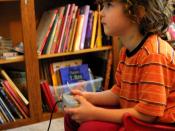Any teacher in today's classroom would gladly give their eyeteeth for an occasional spit-wad in lieu of the steady stream of disruptions that plague most class times. Whole specialized classes are designed for those with various learning or attention disorders. Elementary teachers regularly request children, especially boys, to be medically tested for attention disorders. More children than we care to admit are taking prescribed drugs to slow them down. Attention disorders . . . we hear it everywhere. What is happening with today's children?
We live in a fast-paced world. Electronic chips "rule" our lives. The press of a button cooks the food, entertains us, and cleans us. A whirlwind of sensory stimuli attacks us from every quarter. Our houses are buzzing with TV's, radios, CD players, computers, and other electronic "gizmos." Did you ever long for some peace and quiet within the confines of your own home? When was the last time your family read a book together -- aloud, put a puzzle together, played a lazy game of croquet, roamed the countryside on a spring day enjoying the wild flowers, toured the museum, played charades, or sat around the living room and talked without the TV on? The length of your child's attention span is dependent upon the character of your home life.
A child's brain continues to develop from birth until ages 7-10, and the attention span will be determined by the type of programming his brain receives. Television commercials and fast- paced programs (especially children's programming) and video games are designed for the short attention span. For example, one commercial makes 80 drastic movement changes. A child's brain cannot keep up with these changes, and if he spends too much time in front of the TV in these early years, his brain will not develop...


